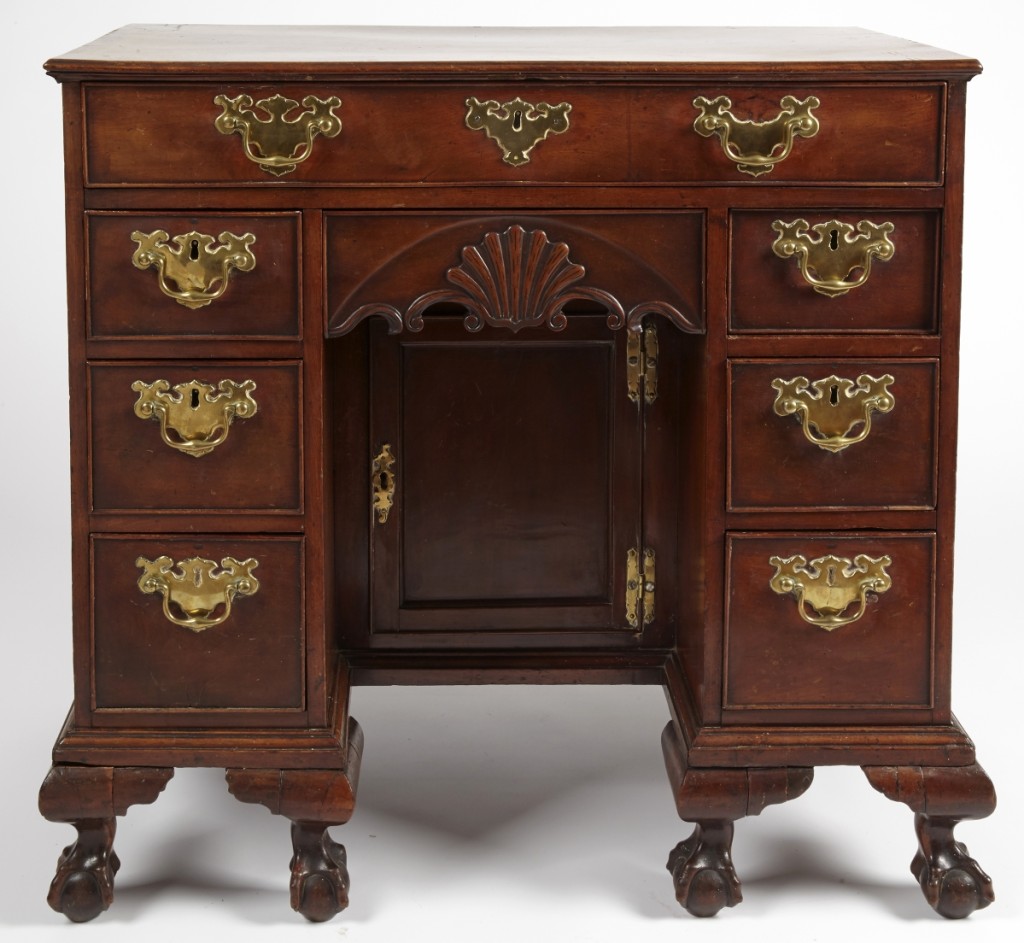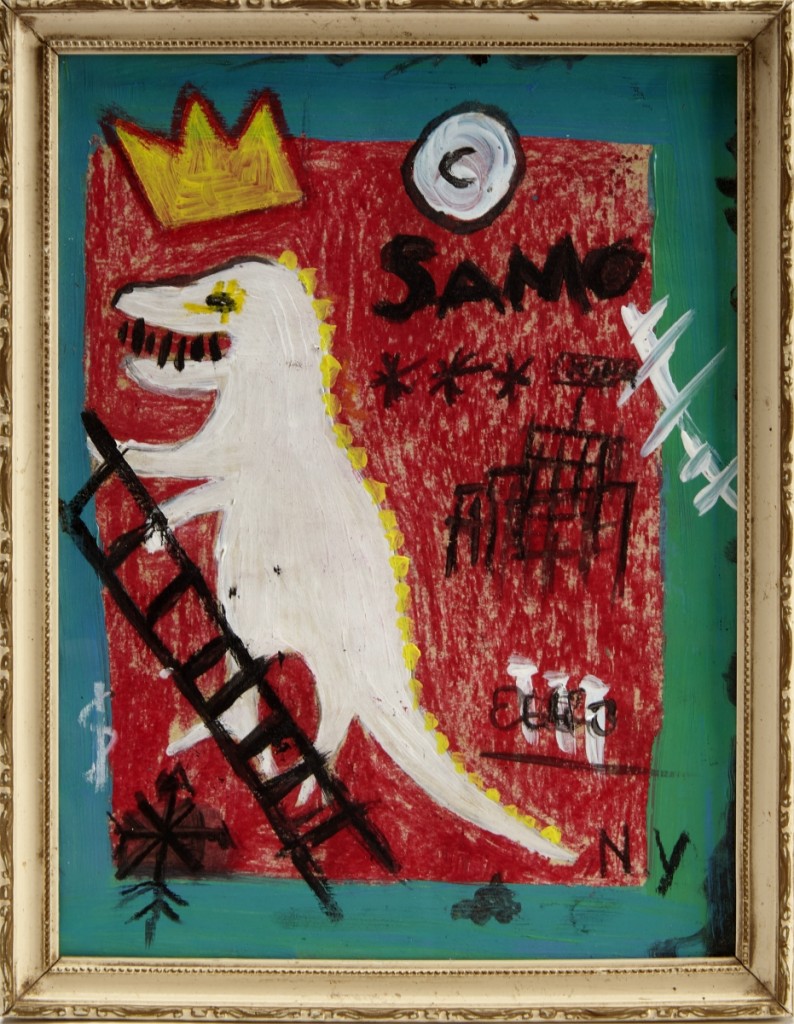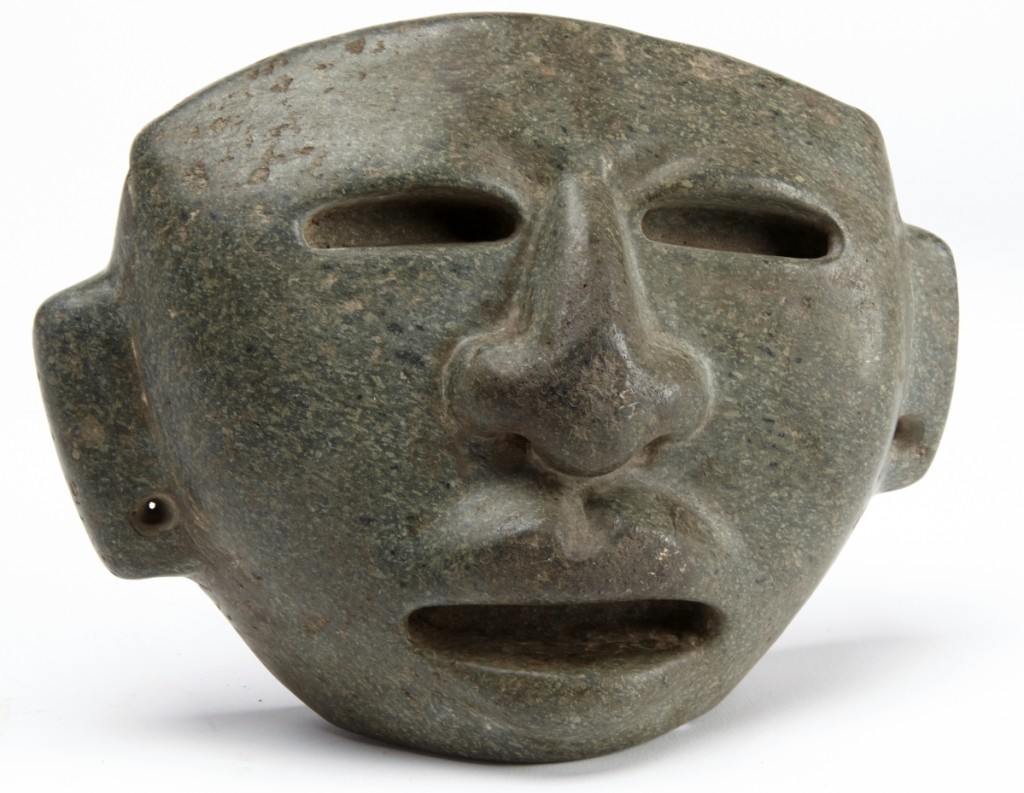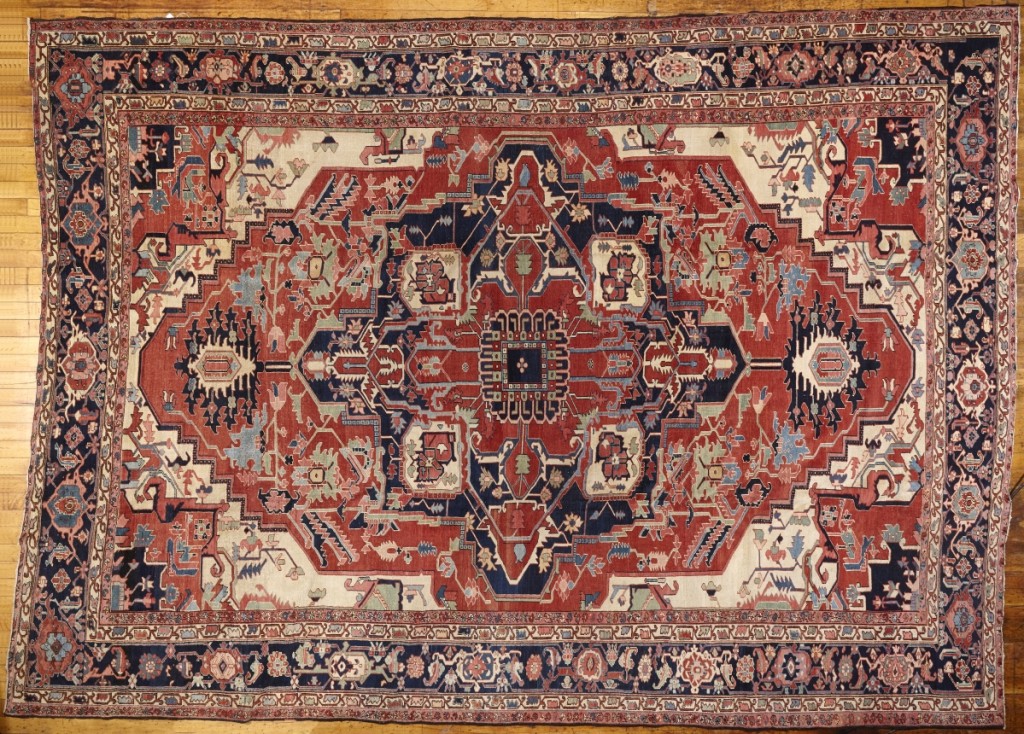
The historic John Adam Dix Chippendale kneehole desk or bureau table, New York, circa 1760, formerly the property of John Adams Dix (1798-1879), a US Civil War major general for Union forces, US secretary of the treasury and US senator, bested its $8/12,000 estimate, selling for $26,250.
Review and Onsite Photos by W.A. Demers, Additional Photos Courtesy of New Haven Auctions
NEW HAVEN, CONN. – Fred Giampietro’s first New Haven Auction of 2020 was a two-day event, January 11 and 12, that saw continued strength in Americana with great provenance, and there were glimmers of hope for the long-beleaguered furniture category – at least for pieces with great provenance or historical importance.
In the firm’s intimate gallery located in an industrial neighborhood approximately 30-40 bidders gathered on each of the days, many of them familiar faces you may see at antiques shows – Barn Star’s Frank Gaglio, New Jersey dealer James Grievo, New York architectural designer Nancy Fishelson, Connecticut dealer Joseph Collins on day one, for example. Yet, for all the continuing support by the trade, Giampietro said two-thirds of the 5,700 registered bidders were retail customers. “I thought the sales were very strong and solid, with a lot of bidders coming a long distance,” said Giampietro afterwards. The two sales totaled $789,200, with day two contributing slightly more than one-half of the total. The online component totaled $369,000. Sharing podium duties were Fred and Kathy Giampietro. There were three busy online platforms and the phones were very active.
Day one featured the Americana collection of Susie and Richie Burmann with approximately 200 lots. The Burmanns are well-regarded collectors, originally from Eaton, Ohio, but now residing in Roxbury, Conn. They formed their collection, rich in folk art over the last 40 years, with items like a rare miniature ogee bracket blanket chest, a group of carved and painted heart-in-hand staffs, watercolor birth and family records, tramp art, boxes, weathervanes and a few pieces of furniture.
Gaglio, who attended both days of the sale, recalls meeting Susie Burmann at a Richard and Libby Kramer show in Indiana, where he was a participating dealer. “It was a fabulous show,” remembers Gaglio. “They literally built a house in the center of the show floor housing individual exhibits inside. I first met Susie when she came into my booth and asked about a chest of drawers,” The Burmanns bought the piece and a friendship was formed, Gaglio visiting their historic, brick home in Eaton, Ohio, formerly the first bank in Preble County. From then on the Burmanns came east from time to time being introduced to other dealers. Richie was a physical education teacher who loved his work and Susie was a “Cattle Baroness” tending to more than 100 head of cattle on her farm and very active in Four H. “They loved the material, they loved the dealers,” said Gaglio.
Indeed, the provenance notations in the handsomely produced full-color sale catalog read like a who’s who of top Americana and folk art dealers – Gaglio, Grievo, Giampietro, Grace & Elliott Snyder, David Good, David Wheatcroft, John Sideli, Barbara Pollack, Courcier & Wilkins, Thomas Moser and others. The auction gallery, small in space, bristled with a wealth of well-loved objects that in the words of one patron “make you smile.”

Unauthenticated by the gallery, what was cataloged as a Jean-Michel Basquiat oil stick on paper work from 1982, 10¼ by 8 inches, was purchased for $24,375.
The top lot in the Burmann collection turned out to be a piece of furniture. A Queen Anne tiger maple highboy, probably New Hampshire, circa 1780, that exhibited a mellow old surface and brasses that appeared to be original, settled at a below estimate $16,250. With a height of 73 inches, the highboy had been purchased by George Samaha for Judge Garrett at Mireau Auction, Doylestown, Penn., in 1953, and sold again at Garth’s Auctions in 1999.
A tiger maple Chippendale chest on chest, circa 1800, did better relative to its estimate, more than doubling the high expectations to sell for $10,000. In untouched condition with original brasses, the piece stood 77 inches high and was in excellent as-found condition.
A Nineteenth Century Serapi Oriental carpet should have done better than it did, according to Gaglio who remembers seeing it in the Burmanns’ home. “It’s a popular design and assimilates well with the furniture, so I believe that was an excellent buy,” he said. Estimated at $5/10,000, the 15-foot-8-inch-by-11-foot-6-inch carpet finished at $9,063.
Fetching the same amount was a two-part cherry Pennsylvania Dutch cupboard, circa 1840. Like most of its ilk, the piece exhibited a beautiful old mellow surface and stood 88 inches high.
The first lot across the block in the Burmann sale was a rare miniature ogee bracket blanket chest with two drawers. A phone buyer snapped up the circa 1800 piece from Pennsylvania, which had Elliott and Grace Snyder and Barbara Pollack provenance, for a below estimate $8,750. In outstanding original condition, it measured 11¾ by 17½ by 9¾ inches.

A Mayan carved stone mask that was believed to be early nearly tripled its high estimate to earn $13,750.
Fred Giampietro believed that a carved and painted Queen Anne mirror, circa 1770, would do well and it did, going to a phone bidder for $7,500 against a $1,5/2,500 estimate. The mirror’s Spanish brown paint appeared to be original. It had previously sold at Sotheby’s in June 1996 and had been included in the American Folk Art Museum’s “The Keene Eye” exhibition in 1984.
The Burmanns’ love for the “heart-in-hand”/”heart-and-hand” tropes in American folk art was evident in the incredible number of objects they amassed with the familiar motif. Used in everything from fraternal lodge totems to German-American Gustave Baumann’s woodblock print chop mark, the heart-in-hand symbolizes charity that is given from the heart. The fraternal lodge connection goes back to the time when the organizations acted like iwnsurance companies for their members. If you belonged to a lodge and paid your dues, you and your family would be taken care of when misfortune visited your home. The Shakers, too, adopted it as a manifestation of the sect’s founder Mother Ann Lee’s adage imploring followers to “Put your hands to work, and your hearts to God.”
There were several heart-in-hand staffs offered from the collection. One, with oversized hand in carved wood with original paint, circa 1880 and 72 inches long, beat its high estimate, going to a phone bidder competing with an in-house bidder for $7,188.
Even more remarkable, though, was a diminutive heart-in-hand watercolor on paper, presumably done by or for Mary S. Hall, Gilmanton, N.H. Housed in a frame of 5¾ by 6¼ inches, it was in excellent original condition, the frame hinged at top to access period handwritten prose on verso, the watercolor soared from its $300/500 estimate to also finish at $7,188.
A Nineteenth Century Tanware figural spaniel with slip decoration concealed a surprise inside its cavity when auction patron Tom Helm of Berwyn, Penn., picked it up to examine it at preview. Folded up inside was an undated clipping from Antiques and The Arts Weekly depicting and describing a similar example. This one stood 7¾ inches tall and had David Good provenance. Estimated just $250/500, it had phone and left bids, ultimately going to an online bidder for $3,125.
Day two of the auction on January 12, presented about 350 lots and included a pair of Maine eider decoys, historic period furniture, a Charles Looff carousel horse and a 2.8-carat diamond, among other items.
Two historic pieces of period furniture crossed the block. The John Adam Dix Chippendale kneehole desk or bureau table, New York, circa 1760, was formerly the property of John Adams Dix (1798-1879), a US Civil War major general for Union forces, US secretary of the treasury and US senator. He was also US minister to France from 1866 to 1869 and served as New York’s 24th governor from 1873 to 1874. As a civilian, Dix was president of the Union Pacific Railroad from 1863 to 1868, during the construction of the first transcontinental railroad. The desk bested its $8/12,000 estimate, selling for $26,250.

A Nineteenth Century Serapi Oriental carpet measured 15 feet 8 inches by 11 feet 6 inches and brought $9,063.
The other storied piece of furniture was the Lyman Beecher (H.B. Stowe) Tracy Windsor chair that was bid to a mid-estimate $13,125. Lyman Beecher (1775-1863) was a minister and the co-founder and leader of the American Temperance Society. He was also the father of American abolitionist and author Harriet Beecher Stowe. The chair was lovingly remembered by Harriet Beecher Stowe in the book Harriet Beecher Stowe: The Story of Her Life. Centered on the back of the arm rail was “L. Beecher.” A shipping label is affixed to the underside of the chair indicated that it traveled with Beecher and his family from Connecticut to Cincinnati in 1832.
Giampietro offered what was cataloged as a Jean-Michel Basquiat oil stick on paper work from 1982 without authentication because Basquiat’s work is not easily authenticated. The owner said he purchased it 20 years ago and it bore an Andre Emmerich Gallery label on back. That apparently was enough for someone to purchase the 10¼-by-8-inch piece for $24,375.
Gallery expertise was also lacking to accurately date a Mayan carved stone mask that nonetheless was believed to be early. It nearly tripled its high estimate to earn $13,750.
An exceptional pair of Maine Eider decoys, circa 1925, came to the podium with a $6/10,000 estimate and exceeded the high expectation a bit, realizing $13,125. From a local estate and attributed to Samuel Toothaker (1903-1974) of Brunswick, Maine, each bird measured 14½ inches long.
The mother of all weathervanes in the sale, a large and impressive banner example, circa 1875, stretched 74½ inches in length and was bid to $10,938. Anyone who had visited Benson’s Animal Farm in Hudson, N.H., before it closed in 1987 would remember seeing this weathervane. Copper with original gilding, complete on its original standard, it had been in dealer John Sideli’s collection.
Additional highlights included a 2.86-carat diamond, GIA-graded, for $8,438; a circa 1880 oil on canvas schooner painting of the Abraham Leggett attributed to Elisha Taylor Baker (1827-1890), taking $6,563; a life-size Nineteenth Century cast iron dalmatian dog attributed to Gray Foundry, Poultney, Vt., bringing $5,750; and two paintings, one by Outsider artist Jon Serl for $5,500, and another by Robert Goodnough, an abstract oil on canvas from circa 1958, that went out at $5,375.
Prices given include the buyer’s premium as stated by the auction house. For information, www.newhavenauctions.com or 475-234-5120.































